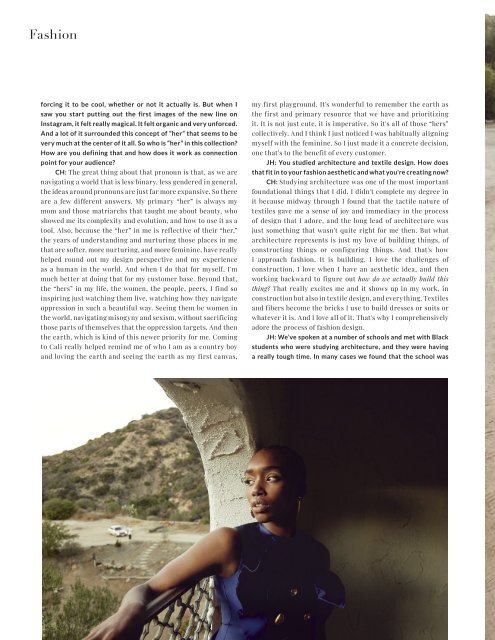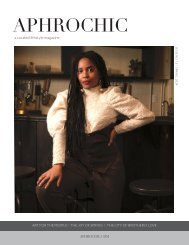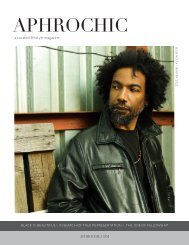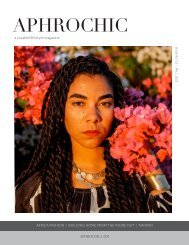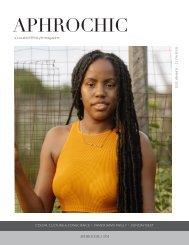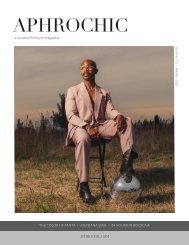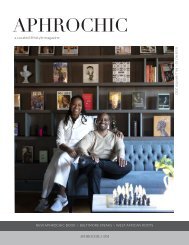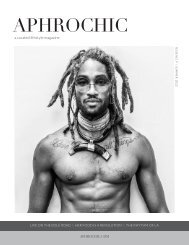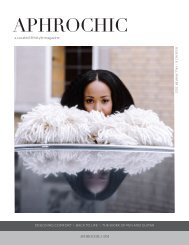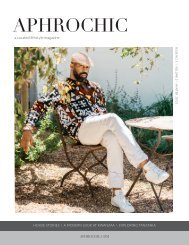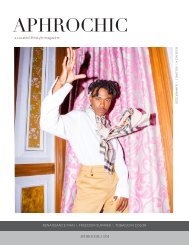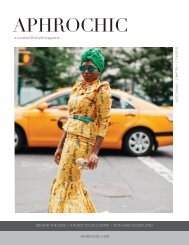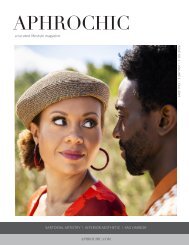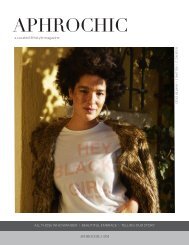Aphrochic Magazine: Issue No. 7
For our Summer 2021 issue, we have an issue full of color, life and all of the things that make our Diaspora beautiful. For our cover story, we are thrilled to sit down with one of our favorite folks in fashion, the amazing Charles Harbison. After a 5-year hiatus and a cross-country jump from New York to Los Angeles, Charles is back with the much-anticipated return of his eponymous fashion line, HARBISON. We also sit down with the iconic Dyana Williams. A legend of the Philadelphia radio scene that we grew up on, she’s better known outside the city as the mother of Black Music Month. We sat down with Dyana to talk about Black music, the newly opened National Museum of African American Music and the artists on her playlist that she feels are doing the most for the culture. In our Hot Topic, AphroChic contributor Ruby Brown takes an incisive look at Pride, all that the LGBTQIA+ community has accomplished and all that’s left to do. And in response to the growing debate over Critical Race Theory, which in the last months has taken over news feeds and legislative floors alike, we take a break from our ongoing discussion of the African Diaspora to offer a brief exploration of CRT, it’s origins, it’s concepts and why it seems to have everyone so upset. Throw in some amazing art from THE CONSTANT NOW gallery in Antwerp, inspirational words from author Alexandra Elle, and the latest updates from the outdoor spaces at the AphroFarmhouse and we think this issue will have you ready for the summer season.
For our Summer 2021 issue, we have an issue full of color, life and all of the things that make our Diaspora beautiful. For our cover story, we are thrilled to sit down with one of our favorite folks in fashion, the amazing Charles Harbison. After a 5-year hiatus and a cross-country jump from New York to Los Angeles, Charles is back with the much-anticipated return of his eponymous fashion line, HARBISON. We also sit down with the iconic Dyana Williams. A legend of the Philadelphia radio scene that we grew up on, she’s better known outside the city as the mother of Black Music Month. We sat down with Dyana to talk about Black music, the newly opened National Museum of African American Music and the artists on her playlist that she feels are doing the most for the culture.
In our Hot Topic, AphroChic contributor Ruby Brown takes an incisive look at Pride, all that the LGBTQIA+ community has accomplished and all that’s left to do. And in response to the growing debate over Critical Race Theory, which in the last months has taken over news feeds and legislative floors alike, we take a break from our ongoing discussion of the African Diaspora to offer a brief exploration of CRT, it’s origins, it’s concepts and why it seems to have everyone so upset.
Throw in some amazing art from THE CONSTANT NOW gallery in Antwerp, inspirational words from author Alexandra Elle, and the latest updates from the outdoor spaces at the AphroFarmhouse and we think this issue will have you ready for the summer season.
You also want an ePaper? Increase the reach of your titles
YUMPU automatically turns print PDFs into web optimized ePapers that Google loves.
Fashion<br />
forcing it to be cool, whether or not it actually is. But when I<br />
saw you start putting out the first images of the new line on<br />
Instagram, it felt really magical. It felt organic and very unforced.<br />
And a lot of it surrounded this concept of “her” that seems to be<br />
very much at the center of it all. So who is “her” in this collection?<br />
How are you defining that and how does it work as connection<br />
point for your audience?<br />
CH: The great thing about that pronoun is that, as we are<br />
navigating a world that is less binary, less gendered in general,<br />
the ideas around pronouns are just far more expansive. So there<br />
are a few different answers. My primary “her” is always my<br />
mom and those matriarchs that taught me about beauty, who<br />
showed me its complexity and evolution, and how to use it as a<br />
tool. Also, because the “her” in me is reflective of their “her,”<br />
the years of understanding and nurturing those places in me<br />
that are softer, more nurturing, and more feminine, have really<br />
helped round out my design perspective and my experience<br />
as a human in the world. And when I do that for myself, I'm<br />
much better at doing that for my customer base. Beyond that,<br />
the “hers” in my life, the women, the people, peers, I find so<br />
inspiring just watching them live, watching how they navigate<br />
oppression in such a beautiful way. Seeing them be women in<br />
the world, navigating misogyny and sexism, without sacrificing<br />
those parts of themselves that the oppression targets. And then<br />
the earth, which is kind of this newer priority for me. Coming<br />
to Cali really helped remind me of who I am as a country boy<br />
and loving the earth and seeing the earth as my first canvas,<br />
my first playground. It's wonderful to remember the earth as<br />
the first and primary resource that we have and prioritizing<br />
it. It is not just cute, it is imperative. So it's all of those “hers”<br />
collectively. And I think I just noticed I was habitually aligning<br />
myself with the feminine. So I just made it a concrete decision,<br />
one that’s to the benefit of every customer.<br />
JH: You studied architecture and textile design. How does<br />
that fit in to your fashion aesthetic and what you're creating now?<br />
CH: Studying architecture was one of the most important<br />
foundational things that I did. I didn't complete my degree in<br />
it because midway through I found that the tactile nature of<br />
textiles gave me a sense of joy and immediacy in the process<br />
of design that I adore, and the long lead of architecture was<br />
just something that wasn't quite right for me then. But what<br />
architecture represents is just my love of building things, of<br />
constructing things or configuring things. And that's how<br />
I approach fashion. It is building. I love the challenges of<br />
construction. I love when I have an aesthetic idea, and then<br />
working backward to figure out how do we actually build this<br />
thing? That really excites me and it shows up in my work, in<br />
construction but also in textile design, and everything. Textiles<br />
and fibers become the bricks I use to build dresses or suits or<br />
whatever it is. And I love all of it. That's why I comprehensively<br />
adore the process of fashion design.<br />
JH: We’ve spoken at a number of schools and met with Black<br />
students who were studying architecture, and they were having<br />
a really tough time. In many cases we found that the school was


